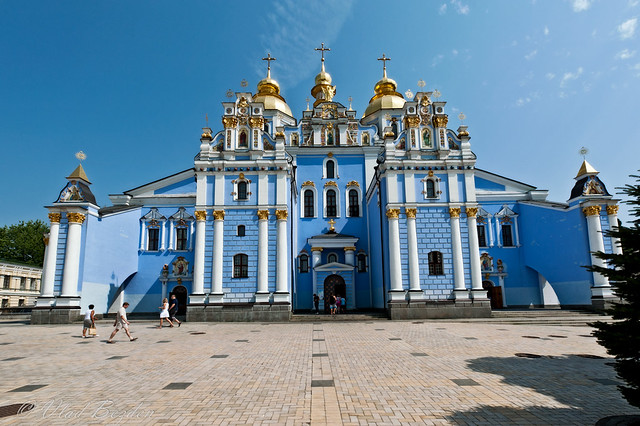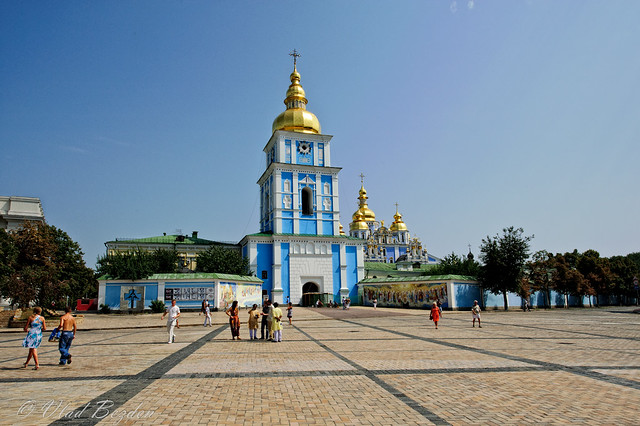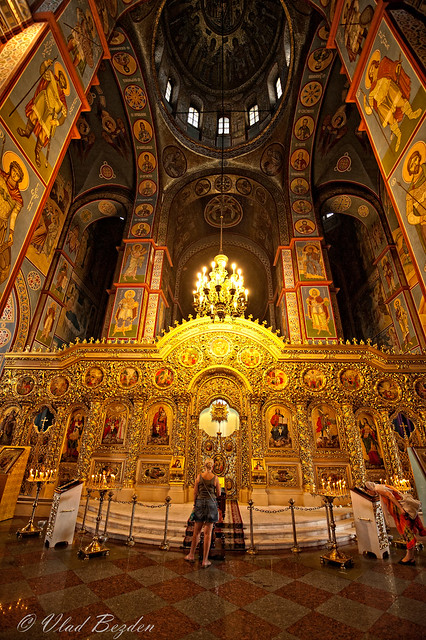Originally built in the Middle Ages by Sviatopolk II Iziaslavych, the monastery comprises the Cathedral itself, the Refectory of St. John the Divine, built in 1713, the Economic Gates, constructed in 1760 and the monastery's bell tower, which was added circa 1716–1719. The exterior of the structure was rebuilt in the Ukrainian Baroque style in the 18th century while the interior remained in its original Byzantine style.The original cathedral was demolished by the Soviet authorities in the 1930s, but was reconstructed and opened in 1999 following Ukrainian independence.

11th to 19th centuries
Some scholars do not believe that Prince Iziaslav Yaroslavych, whose Christian name was Demetrius, first built the Saint Demetrius's Monastery and Church in the Uppertown of Kiev near Saint Sophia Cathedral in the 1050s. Half a century later, his son, Sviatopolk II Iziaslavych, is recorded as commissioning a monastery church (1108–1113) dedicated to his own patron saint, Michael the Archangel. One reason for building the church may have been Svyatopolk's recent victory over the nomadic Polovtsians, as Michael the Archangel was considered a patron of warriors and victories.
The Mosaic of St. Demetrius was installed by Sviatopolk II in the monastery cathedral to glorify the patron saint of his father.
The monastery was regarded as a family cloister of Svyatopolk's family; it was there that members of Svyatopolk's family were buried. (This is in contrast to the Vydubychi Monastery patronized by his rival, Vladimir Monomakh). The cathedral domes were probably the first in Kievan Rus to be gilded, a practice that became regular with the passage of time and acquired for the monastery the nickname of "golden-domed" or "golden-roofed", depending on the translation.
During the Mongol invasion in 1240, the monastery is believed to have been damaged seriously. The Mongols damaged the cathedral and removed its gold-plated domes. The cloister subsequently fell into disrepair and there is no documentation of it for the following two and a half centuries. By 1496, the monastery had been revived and its name was changed from St. Demetrius' Monastery to St. Michael's after the cathedral church built by Sviatopolk II.After numerous restorations and enlargements during the sixteenth century, it gradually became one of the most popular and wealthiest monasteries in Ukraine.In 1620, Iov Boretsky made it the residence of the renewed Orthodox metropolitan of Kiev, and in 1633, Isaya Kopynsky was named a supervisor of the monastery.
The monastery enjoyed the patronage of hetmans and other benefactors throughout the years. The chief magnet for pilgrims were the relics of Saint Barbara, alleged to have been brought to Kiev from Constantinople in 1108 by Sviatopolk II Iziaslavych's wife and kept in a silver reliquary donated by Hetman Ivan Mazepa. Although most of the monastery grounds were secularized in the late eighteenth century, as many as 240 monks resided there in the nineteenth and twentieth centuries. The monastery served as the residence of the bishop of Chernigov after 1800. A precentor's school was located on the monastery grounds; many prominent composers, such as Kyrylo Stetsenko and Yakiv Yatsynevych, either studied or taught at the school.
In 1870, about 100,000 pilgrims paid tribute to St. Barbara at St. Michael's Monastery. Before the Russian Revolution in 1917, rings manufactured and blessed at St. Michael's Monastery, known as St. Barbara's rings, were very popular among the citizens of Kiev. They usually served as good luck charms and, according to popular beliefs, occasionally protected against witchcraft but were also effective against serious illnesses and sudden death. These beliefs reference the facts that the Monastery was not affected by the plague epidemics in 1710 and 1770 and cholera epidemics of the nineteenth century.
























